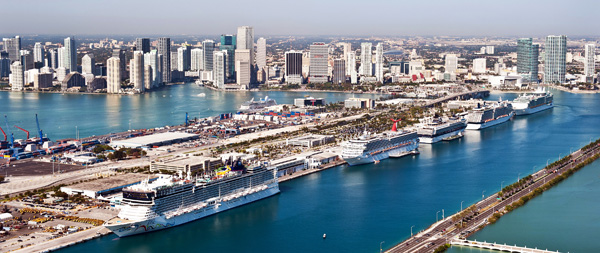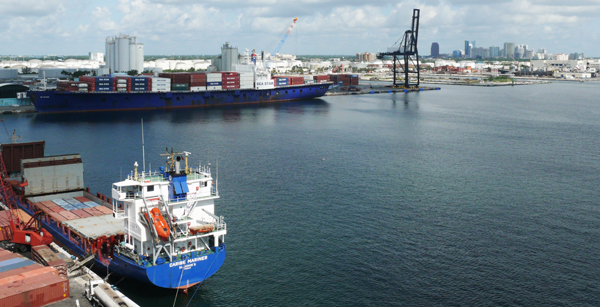FT. LAUDERDALE, FLA. - The man wrapping the bathing suit I’ve just bought in the store on trendy Las Olas Blvd. asks if I’m a passenger on one of the cruise ships that dock daily at nearby Port Everglades. Before I can answer, Keith Glasco, the manager of the Tommy Bahama outlet tells me that the cruise industry “means a lot” to his business.
“I’ve been trying to get our head office in Seattle to increase its advertising in cruise magazines to help drive even more business to my store,” says Glasco. “Cruise passengers contribute so much to our city’s economy and I know how much my store benefits when they’re hanging around town waiting for their ship to sail.”
A few days later, while sitting in the palatial lobby of Miami’s chicest hotel, the Mandarin Oriental on Biscayne Bay, Wendy Blandon, the property’s Leisure Sales Manager, echoes Glasco’s claim that the cruise industry props up so many other businesses in South Florida.
“Cruise passengers always arrive a few days early just to insure they won’t miss the boat, so to speak,” smiles Blandon, who says her hotel, located just a short drive from Miami’s ultra-modern cruise port — the largest in the world — welcomes lots of pre-sail passengers.
“I can’t put an exact dollar amount on what the cruise industry means to our hotel but it’s substantial,” says Blandon.

Above: Miami’s gigantic cruise terminal is the biggest in the world.
If anyone doubts the impact cruise ships have on Miami and Ft. Lauderdale, consider this:
• The cruise industry contributes more than $18 billion U.S. annually to the South Florida (Miami and the Ft. Lauderdale) economy.
• More than 176,000 jobs are dependent on the industry in South Florida.
• More than 7 million passengers pass through the ports of Miami and Ft. Lauderdale annually.
• One in seven cruise passengers in the world leaves from the Port of Miami each year.
• Tax revenues generated by the industry contribute significantly to state coffers.
No wonder they call South Florida “the cruise capital of the world.”
And while other segments of the travel industry continue to feel the pain of ailing economies in North America and Europe, the cruise industry has been able to navigate through the troubled economic waters pretty much unscathed.
“That’s because cruise lines still offer the best travel value and they have a very loyal clientele. They’re getting bigger so we have to keep expanding and upgrading our port facilities to meet the industry’s needs,” says Richard de Villiers, Business Initiatives Manager for the Port of Miami, who, while not claiming it’s going to be all calm seas ahead, does see good days on the horizon for cruise ports like his.
“We’ve just opened a new cruise terminal for our Carnival line ships and other improvements are in the planning stage — maybe even bigger terminals,” says the delightful De Villiers, who leads me on a tour of the massive port, which welcomed 4.3 million passengers and more than 700 cruise ships in 2010.

Above: Ft. Lauderdale’s cruise terminal is also a cargo port.
De Villiers and other Port of Miami officials, like Business Development Manager Hydi Webb whom I meet on our tour, are most excited about a tunnel being built which will soon connect the cruise docks with an Interstate highway leading directly to Miami International Airport, where more than 30 million people land annually.
“The tunnel will speed up the processing of cruise passengers — we can run shuttle buses right from the airport and avoid downtown traffic when the project is completed (in 2012),” says Webb.
The gigantic new terminal that the Port of Miami built for Carnival looks like a mini airport, complete with sophisticated security equipment, state-of-the-art baggage handling areas and customs halls designed to make embarking and disembarking the massive ships easy and painless.
We wish airports worked this efficiently.
The millions of tons of provisions the large ships must carry to feed its army of passengers is supplied by local companies and that, according to de Villiers, means millions more dollars are pumped into the local economy each year.
It’s much the same story over at Port Everglades — maybe even better.
In 2010, cruise traffic generated a record $45.7 million in revenue for the port, which sits a short cab ride from downtown Ft. Lauderdale. That’s a 22 per cent increase in revenues over 2009, and the 17 per cent increase in cruise passenger traffic Port Everglades saw in 2010 signals a bright future here.
Much of Port Everglades’ success can be traced to the fact it took a gamble in 2008 and spent $75 million to upgrade its Terminal 18 to welcome Royal Caribbean’s gigantic Oasis Class ships.
The terminal went from 67,500 square feet to more than 240,000 square feet and was transformed into one of the most modern passenger terminals in the world.
For its efforts, Port Everglades was rewarded with a long-term contract from Royal Caribbean, whose corporate head offices, ironically, is located at the Port of Miami.
Royal Caribbean’s 5,400-passenger Oasis of the Sea, the largest cruise ship in the world, sailed into Port Everglades in 2009 and nestled up against Terminal 18, which offers seating for 5,400 guests.
However, Terminal 18’s high-speed counters move passengers from curb to deck chairs at warp speed.
“The process is so fast, we are finding not many people sit in the waiting area — they arrive and within 10 minutes they’re on board,” says Ellen Kennedy, the Public Relations Manager for Port Everglades. “That means the terminal looks pretty empty, even on busy days.”
The Ft. Lauderdale port spared no expense in creating Terminal 18 and the sea-themed artwork in the public hall — the genius of international artist Michele Oka Doner — is truly inspiring.
Cruise traffic is always high at Port Everglades, which last year set a one-day record for passenger movement when 54,365 people passed through (March 20, 2010).
The Oasis Class ships alone are expected to generate 584,000 passenger movements at Port Everglades during the busy 2011-12 fall/winter season.
More expansion is on the way at Port Everglades, thanks to its own long-term (15-year) agreement with Carnival Cruise Lines.
“We’ll be renovating four existing terminals at a cost of about $34 million to meet the demand of the Carnival brand ships (Princess Cruises, Holland America Line, Carnival Cruise Line, P&O Cruises, Costa Cruises, Cunard Line and Seabourn vessels all fly Carnival’s corporate flag) and that will create more than 600 new construction jobs,” says Kennedy.
That’s welcome news for South Florida, whose construction industry has still not recovered from the collapse of the U.S. housing market a few years ago.
There’s a lot of rivalry between the two ports — de Villiers does not hide his disappointment that his facility lost the Oasis Class ships to Ft. Lauderdale.
But with the opening of the new Port of Miami tunnel; the continuing dredging of the port’s cruise canal to allow even bigger ships to dock; and the upgrading and expansion of existing terminals at his port, de Villiers suggests things will be different in the future.
Port Everglades’ Kennedy admits her facility will have to stay on its toes to fend off the Miami challenge.
But, she says, with her port’s proximity to Ft. Lauderdale International Airport — it’s adding a new runway to welcome even more cruise passengers; the fact that a convention centre is located on port property; and with its commitment to spending what it takes to keep the cruise industry happy, she’s also confident about the future.
Both ports appear well positioned to sail into a bright future — that’s because they’re both on cruise control.
Information
When Royal Caribbean’s Oasis of the Seas leaves port for a week-long cruise, this is just some of the things it takes along to keep its 5,400 passengers happy:
• 11,399 kg of beef
• 6,800 kg of chicken
• 4,535 kg of seafood
• 36,387 kg of fresh vegetables
• 16,782 kg of fresh fruit
• 3,310 kg of cheese
• 35,000 fresh eggs
• 22,000 slices of pizza
• 37,800 litres of ice cream
• 18,000 rolls of toilet paper